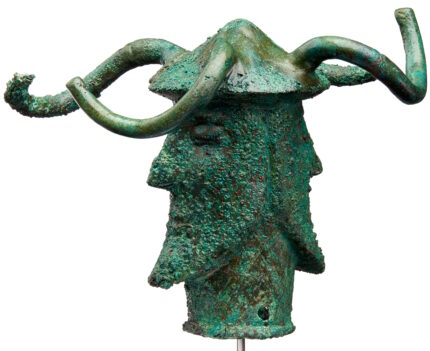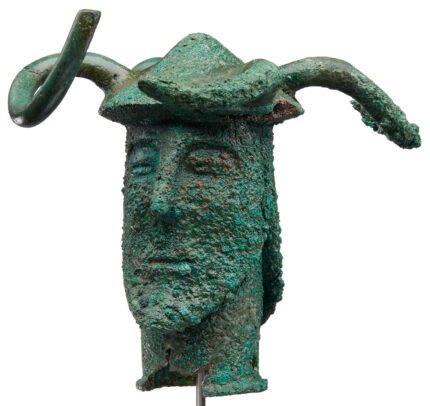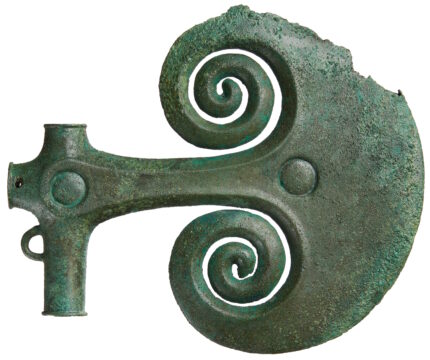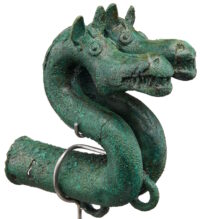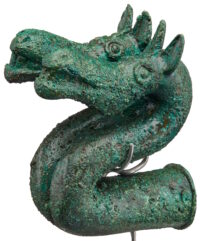The hoard of unique Bronze Age artifacts discovered in Kallerup, outside of Thisted, Denmark, in 2019 is heading back home in a landmark exhibition for the opening of the new Thisted Museum.
The Kallerup Hoard is a grouping of four bronze figurines of exceptional craftsmanship and quality discovered during an archaeological survey at a site slated for development. The bronze figure of a double-faced man wearing a horned helmet on each head was first discovered in a field by a metal detectorist working with archaeologists from the Museum Thy. The top of a large ceremonial axe, also bronze, emerged next. A foot in diameter with spiral ends, the axe was removed in a soil block for excavation in laboratory conditions. A CT scan of the block revealed two more double figurines with heads of horses and serpentine bodies.
Thorough excavation and conservation of the grouping took months. The cleaned-up Kallerup Hoard made its debut at Denmark’s National Museum in January 2020. The exhibition emphasized the motif of dualism in the religious art of Bronze Age Denmark, as seen in the double-headed horned helmeted man and the serpentine double horses.
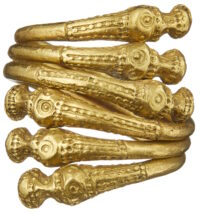 The hoard is owned by the National Museum, but it will be on long-term loan to the Thisted Museum. The loan will have to be renewed every five years, but the expectation is that the renewals will repeat indefinitely so that the hoard can remain within a stone’s throw of its original context. The new museum is much larger than its predecessor with more than 17,000 square feet of exhibition space over three buildings. Seven permanent exhibitions will showcase the area’s history and prehistory going back to the Stone Age with archaeological materials found in the area.
The hoard is owned by the National Museum, but it will be on long-term loan to the Thisted Museum. The loan will have to be renewed every five years, but the expectation is that the renewals will repeat indefinitely so that the hoard can remain within a stone’s throw of its original context. The new museum is much larger than its predecessor with more than 17,000 square feet of exhibition space over three buildings. Seven permanent exhibitions will showcase the area’s history and prehistory going back to the Stone Age with archaeological materials found in the area.
 The grand opening is on June 24th, and the Kallerup Hoard will be sharing space with other spectacular local finds, like the Ydby runestone, a gold six-ring bracelet, amber jewelry and grave goods from an Iron Age warrior’s burial, including a wooden pot spoon that is the certainly best-preserved and perhaps the only Iron Age pot spoon found in Denmark. (The other possibilities are too damaged to be conclusively identified as pot spoons.)
The grand opening is on June 24th, and the Kallerup Hoard will be sharing space with other spectacular local finds, like the Ydby runestone, a gold six-ring bracelet, amber jewelry and grave goods from an Iron Age warrior’s burial, including a wooden pot spoon that is the certainly best-preserved and perhaps the only Iron Age pot spoon found in Denmark. (The other possibilities are too damaged to be conclusively identified as pot spoons.)
